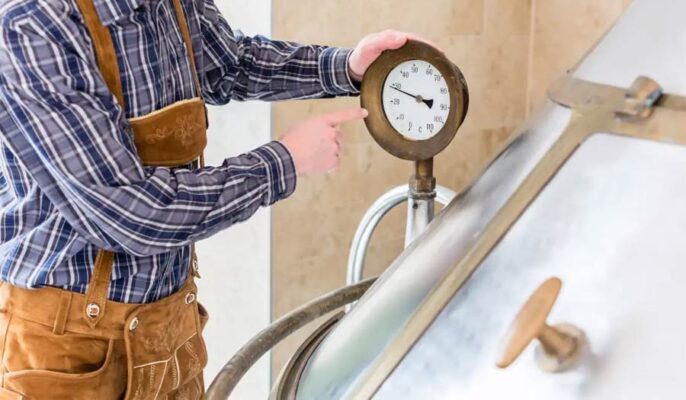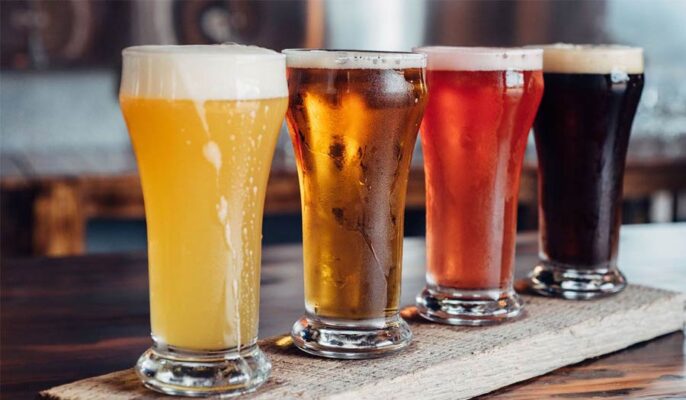Besides to yeast health, controlling fermentation temperature is a rule that winemakers should always follow. We all know that beer is made from barley malt, hops, yeast, and water. But what many people don’t know is that the temperature at which the fermentation process occurs can affect the flavor and aroma of the final product. So, how does temperature affect beer fermentation? In this article, we’ll take a closer look at the relationship between temperature and fermentation.
How does temperature affect beer?
Fermentation at higher temperatures can produce off-flavors in beer, such as fruity esters and solvent-borne higher alcohols. Acetaldehyde (green apple), in particular, is produced much faster at elevated fermentation temperatures and is one of the most common defects in homebrew. Fermentation below the yeast range reduces these metabolites but also suffers from slow fermentation, poor fermentation initiation and possible decay.

How does temperature affect fermentation?
The temperature has a direct effect on fermentation. Yeast produces more alcohol and less carbon dioxide when the weather is warm. Fermentation can happen faster and more in hot weather, causing problems like airlock leaks and even explosions. But, when the weather is cold, the yeast produces less alcohol and more carbon dioxide.
Keeping the temperature within a certain range is important to maintain a consistent rate of fermentation. For most yeast, this range is between 68-72 degrees Fahrenheit.
- If the temperature is too high, they will be overworked and even die.
- When the temperature is too low, they will lose power and become sluggish.
- At Right, they work to turn sugar into alcohol, aka beer.
Why does fermentation increase with temperature?
Yeast produces enzymes that work at specific temperature ranges. The enzymes that convert sugar to alcohol can only work at a certain temperature. Too, yeast reproduction increased with increasing temperature. It depends on the yeast strain.
What happens when the temperature gets too high?
When the fermentation temperature is too high, the yeast cells produce too much alcohol and become stressed. This can stop the fermentation process and even kill the yeast cells. Thus, beer has a higher alcohol content. Beer can develop off-flavors from yeast cells being stressed. Maintaining a consistent fermentation temperature is very important to avoid these problems. If the temperature rises too high, try cooling the fermenter tank.
When should the fermentation temperature be increased?
Start at a temperature lower than the ideal temperature for your target. You can then continue upwards after active fermentation (about three days after pitching).
Methods as below:
- Take the average of the operating temperature range for the selected beer type and apply it to the active fermentation process.
- Increase the temperature by one or two degrees Fahrenheit (a little over 1/2 to 1°C) each day until fermentation is complete. Unless you’re sure you know what you’re doing, you should confirm completion with a hydrometer reading.
Cold Fermentation vs. Warm Fermentation
There are two main types of fermentation: cold fermentation and warm fermentation. Cold fermentation occurs at temperatures below 60 degrees Fahrenheit, while warm fermentation occurs at temperatures above 60 degrees Fahrenheit.
Cold fermentation
Cold ferments ferment , resulting in a beer that tastes cleaner and has fewer off-flavors. Cold fermentation helps preserve the hops in the beer, giving the beer a brighter flavour. But cold fermentation is difficult to control and yields are low.
Warm fermentation
Warm fermentation ferments , and due to the high temperature, it will produce beer odor. Warm fermentation can cause the hops in the beer to degrade, resulting in a less flavorful final product. But warm fermentations are easier to control than cold fermentations, and yields are usually higher.
The ideal temperature for beer fermentation
For beer brewing, temperature is one of the most important factors. The type of yeast used and the fermentation process will determine the ideal brewing temperature. In general, the ideal temperature for brewing beer is between 60 and 70 degrees Fahrenheit. This range allows the yeast to remain active so that it doesn’t generate too much heat that can lead to off-flavors. Also, the cooler end of the range ensures that the beer doesn’t develop excessive acidity.
Malt wine fermentation temperature
Ale fermentation is the process of converting the sugars in the malt into alcohol and carbon dioxide gas. The temperature at which fermentation occurs plays an important role in the final flavor and character of the beer. These higher temperatures promote the growth of specific types of yeast, resulting in flavors that are often described as fruity or spicy.

IPA fermentation temperature
For most IPAs, the ideal fermentation temperature is 68-72 degrees Fahrenheit. This temperature range will allow the yeast to develop the desired flavor without excessive heat or sweetness. Brewers new to making IPAs should start fermentations at the lower end of this range and then adjust to their liking.
Lager fermentation temperature
Lager fermentation is the process of brewing beer at lower temperatures. This type of fermentation produces a clean, crisp flavor. The ideal temperature for larger fermentations is 45-55 degrees Fahrenheit. Most breweries use chillers or basements to maintain these temperatures. If the temperature is too high, the beer will develop off-flavors. If the temperature is too low, the beer will not ferment .
Dark beer fermentation temperature
Seasoned brewers know that the fermentation temperature of a stout is critical to the finished product. Too high a temperature produces a rough, astringent beer, while too low a temperature produces a thin, flat beer. The ideal fermentation temperature for stouts is 60 to 70 degrees Fahrenheit. This range allows the yeast to ferment the sugars in the wort, resulting in a full-bodied and flavorful beer.
In conclusion
Temperature is an important factor to consider when brewing beer. Too high a temperature can cause off-flavors in the beer. Too low a temperature will slow down the fermentation process and affect the taste of the final product. If you want to learn more or need to buy cooling fermentation equipment, welcome to contact micet!





Hi therе to every one, it’s genuinely a fastidious
for me to go to see this website, it ϲontains precious Information.